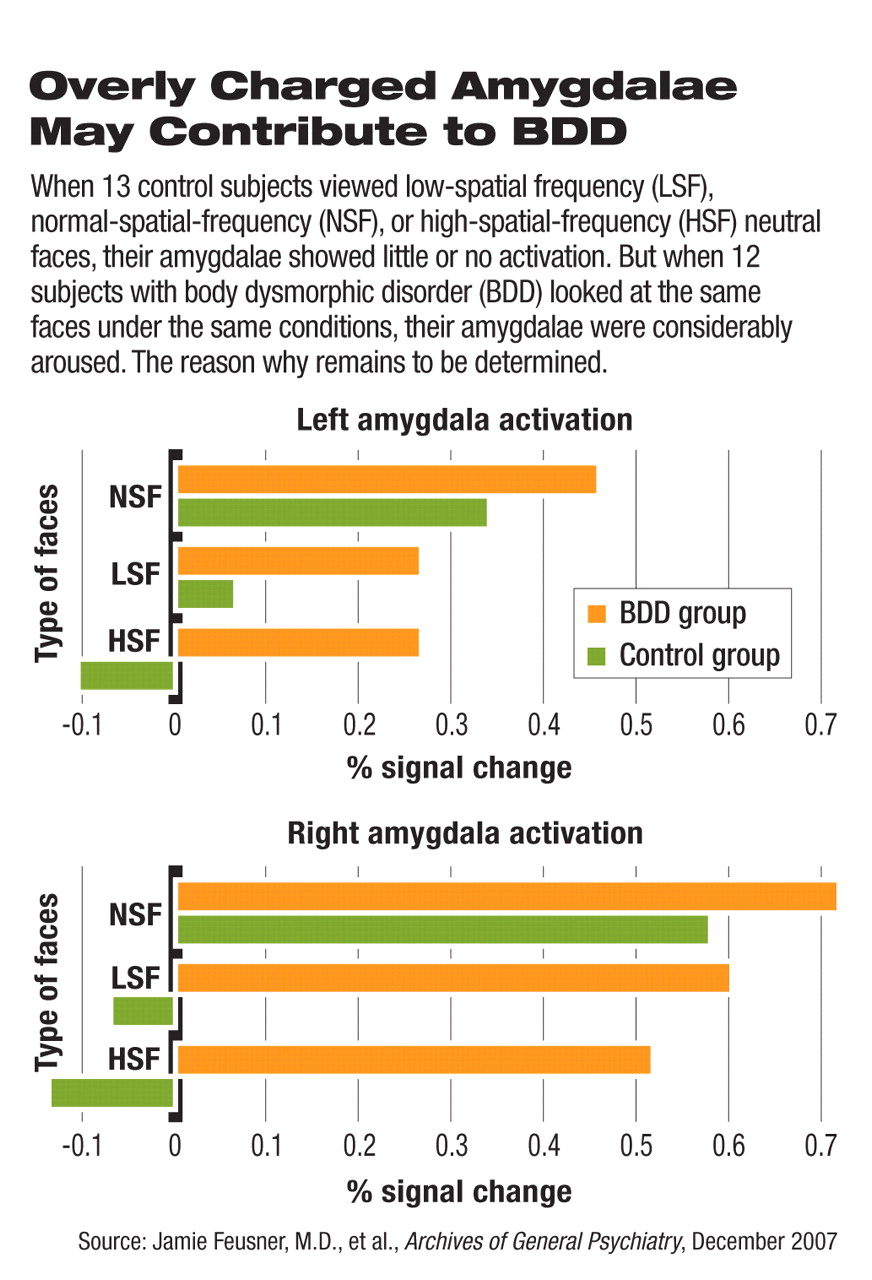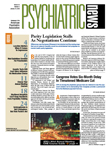Why do individuals with body dysmorphic disorder (BDD) tend to perceive themselves as disfigured and ugly? It may be due, at least in part, to visual-processing abnormalities.
Several years ago, for instance, subjects with BDD and healthy control subjects were presented computerized images of their respective faces. A number of the BDD subjects, but none of the controls, perceived distortions that were not present.
But if BDD can be blamed, at least in part, on visual abnormalities, why is this so? It may be because of abnormal visual processes in the brain, a study published in the December 2007 Archives of General Psychiatry suggests. It was headed by Jamie Feusner, M.D., an assistant professor of psychiatry at the University of California at Los Angeles Department of Psychiatry and Behavioral Sciences.
Feusner and his team also wanted to find out whether persons with BDD experience abnormal patterns of brain activation—only this time while visually processing other people's faces to minimize “the influence of distorted self-representations and symptom provocation.” Their subjects included 12 individuals with the disorder and 13 control subjects matched by age, gender, and educational achievement.
The subjects were given facial-perception tasks. During each task, subjects viewed on a computer screen three digitized photographs of three neutral-expression faces positioned so there was a target face on top and two faces on the bottom. They were instructed to “Choose the face [from the two selections] on the bottom that is the same face as the one on the top, by pressing the right or the left button.” The tasks were designed to be easy enough that it would be unlikely to result in behavioral differences between subjects with the disorder and control subjects.
The faces shown during the tasks were either of normal spatial frequency, high spatial frequency, or low spatial frequency. “Detailed analysis of facial traits such as edges depicting contours of the nose, eyes, eyelashes, skin blemishes, and exact shape of the mouth,” wrote the authors,“ relies on fine spatial resolution and texture analysis, which is conveyed by high-spatial-frequency visual information.” Configural aspects of faces such as the general shape of the face and relative position of the eyes to the mouth are primarily conveyed by low-spatial-frequency visual information, they added.
The researchers used functional magnetic resonance imaging (fMRI) to visualize subjects' brain activity as they engaged in various facial-perception tasks.
More Left-Hemisphere Use Found
BDD subjects visually processed faces during the various tasks differently from control subjects. Most notably, controls used the left hemisphere of the brain for viewing faces with high spatial frequency, but the BDD subjects used it not just for that purpose, but also to view faces with low spatial frequency or normal spatial frequency.
These results suggest that “subjects with BDD demonstrate fundamental differences from controls in visually processing others' faces,” Feusner and his colleagues concluded. Moreover, “the finding of greater left hemisphere activations suggest that subjects with BDD may rely more on extraction and processing of details.” And if that is the case, then it might explain why “patients with BDD often report honing in on details of their appearance. .that they perceive are defective.”
Furthermore, when BDD subjects looked at high-spatial-frequency faces, normal-spatial-frequency faces, and low-spatial-frequency faces, their amygdalae were aroused. This was not the case when control subjects looked at the same faces.
“We were surprised by this finding,” Feusner told Psychiatric News. “In fact, a previous study in healthy controls had shown that... even [faces] with fearful expressions do not cause amygdala activation. We need to perform further studies to better understand the reason for this abnormal activation.”
A more pressing challenge, however, is to find out whether the visual-processing abnormalities that persons with the disorder experience while viewing other people's faces also occur when they view their own faces. Feusner and his team are now trying to answer this question. Another challenge is to determine whether BDD subjects experience visual-processing abnormalities only when they view faces or also when they view other things.“ We are testing visual processing for objects (houses),” Feusner said.
Clinical Implications Cited
Meanwhile, Feusner believes that the study results that they've just published have important clinical implications. “Information about the underlying pathophysiology of BDD may be able to help clinicians better understand it and therefore better identify it in their practice. When patients seem to home in on small details of their appearance (or aspects that are difficult to see for outside observers) and are unable to see the 'bigger picture,' this should be a red flag that the diagnosis may be BDD. Unfortunately, BDD is often missed in clinical practice.”
“This study is just the beginning of a line of research that should provide more information on the pathophysiology of BDD and how it relates to the symptomatology,” Feusner added. “Ultimately we hope to be able to use this information to develop new treatments such as perceptual retraining to help individuals with BDD perceive themselves more accurately.”
“Dr. Feusner's study is groundbreaking,” Katharine Phillips, M.D., a professor of psychiatry at Brown University and a BDD authority, told Psychiatric News. “The finding that people with BDD visually process faces differently from healthy controls provides an important window on neurobiological processes that may be involved in BDD's pathophysiology, about which little is known. What's exciting is that this finding may explain what we see clinically, which is that people with BDD over-focus on minor details of their appearance that others don't notice. These results are also compatible with a neuropsychological study of BDD, in which participants over-focused on isolated details in a complex figure, rather than on large, global features—in other words, they had trouble seeing the forest for the trees.”
The study was funded by the National Institute of Mental Health and several other organizations and foundations.

